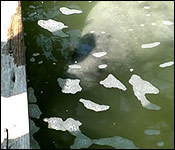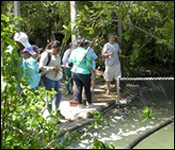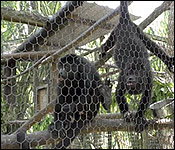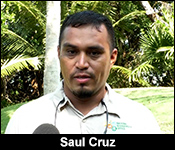

 Yesterday, we took you to the Corozal Bay Wildlife Sanctuary where you got to meet the fishermen of Sarteneja and the organization that ensures they will have a livelihood for generations to come.
Yesterday, we took you to the Corozal Bay Wildlife Sanctuary where you got to meet the fishermen of Sarteneja and the organization that ensures they will have a livelihood for generations to come.
It was part of a biodiversity tour, organized by the National Biodiversity Office, whose goal is to preserve Belize's environment and ensure that every species, whether mammal, fish, bird, or reptile, can continue to co-exist with humans.
And for the second part of the tour, they took the media to Wildtracks Manatee Rehab Center. Courtney Menzies tagged along and has this story.
This three year old manatee came all the way from Mahahual, Mexico, where she was trained to interact with humans. Now, she's at the Wildtracks Manatee Rehabilitation Center, learning how to survive in the wild.
Wildtracks has been rehabilitating manatees since the 90's, and the organization has built up a reputation for being one of the most successful facilities in the world. According to director, Paul Walker, they'll find their manatees swimming happily for over a decade after release.
Paul Walker, Director, Wildtracks
 "As the manatee rehabilitation center, we're responsible to receive any injured or orphaned manatees from around the country, try and save them if they can be saved, rehabilitate them, get them back to good physical and mental health, let them learn the lifeskill needed for life in the wild, and then release them back in the wild and it's a process that takes about three and half to four and a half for manatees and it's a process that's being evolved, we've evolved and developed that process over the years and have the highest success rate of any facility in the world in terms of post-release survivorship. 100% of the manatees have been alive, well, thriving at least a year after release, through the tracking period, and that's up to 13, 14 years some of the manatees are being seen post-release doing absolutely fine."
"As the manatee rehabilitation center, we're responsible to receive any injured or orphaned manatees from around the country, try and save them if they can be saved, rehabilitate them, get them back to good physical and mental health, let them learn the lifeskill needed for life in the wild, and then release them back in the wild and it's a process that takes about three and half to four and a half for manatees and it's a process that's being evolved, we've evolved and developed that process over the years and have the highest success rate of any facility in the world in terms of post-release survivorship. 100% of the manatees have been alive, well, thriving at least a year after release, through the tracking period, and that's up to 13, 14 years some of the manatees are being seen post-release doing absolutely fine."
But it's not just manatees - monkeys who've been injured or discovered being kept illegally are also brought to Wildtracks.
Some, Rafiki here, will have to remain in captivity since he was born with a severe case of scoliosis.
But others are also taught to swing from branches and find food before they are released back into the wild.
Paul Walker, Director, Wildtracks
"The monkey program started later, so we've been rehabilitating manatees since 1999, the monkeys we started rehabilitating in 2010. Far large in numbers, but it's a similar parallel process to make sure we can bring them to good physical and mental health and enable them to learn the lifeskill in the wild. We've now released 88 howler monkeys back into the wild with a 95% post-release survivorship, so again it's double the success rate of anywhere else in Latin America, paralleling our success with the manatees. The monkeys we've released are breeding, it's a re-influxion of an endangered species back into their former range, the northeast biological corridor. We've released 88 monkeys as I've mentioned, they've had first and second generation wild born babies there so although they're being raised by us, brought up by us, they are monkeys, they know how to raise their own families in the forest and the population is thought to have grown between 150 and 200 animals from the 88 that we've released."
But Wildtracks can't do it on their own, and Walker says it's takes teamwork to save these mammals.
Paul Walker, Director, Wildtracks
"For a manatee that's going out, knowing how to find its food in the lagoon, for a monkey, that's being able to climb around in the trees, not fall out of the trees, to find their food, how to breed and everything else. So when both programs are being very successful, very demanding, very challenging, quite expensive to operate and require a lot of collaboration. Both programs require national coordination, the government, the non-government organization, and concerned citizens around the country. So it's only through that collaborative support that we have the success rate that we have."
The visit to Wildtracks was part of the National Biodiversity Office's media tour to showcase the different species that can be found in a single small area - in this case, Sarteneja Village.
And the acting director highlighted the importance of the work to bring back and preserve Belize's biodiversity, and how everyday Belizeans can help save the environment.
 Saul Cruz, Acting Dir., National Biodiversity Office
Saul Cruz, Acting Dir., National Biodiversity Office
"I think that we could see from our marine components from the Corozal Bay Wildlife Sanctuary now to inland looking at the management of manatees that are released back into the sea, the monkeys that come from the mainland and so the impacts that affect some of these wildlife species based on our inland activities, land use chains, agriculture and some of these things, again, as the minister mentioned a lot of times as farmers clean and they light their fires, they go home and don't have proper management of these land uses aspects and then that eventually escalates into something much bigger and into much higher impact."
"There's a lot of work that has been going on to bring back the biodiversity, to bring back somewhat of a natural state of these ecosystems so that would have culminated the tour today, looking at that inland to sea approach and looking at how that connectedness from what we do inland affects many times what happens out in the sea as well."



